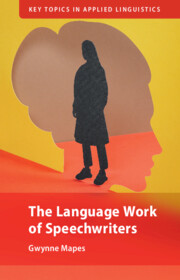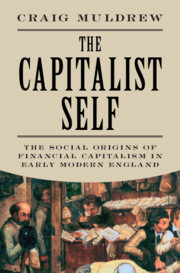Refine search
Actions for selected content:
113 results
1 - The Framework of Analysis
- from Part I - Theory and Framework
-
- Book:
- Incentive Bargaining and Corporate Governance
- Published online:
- 12 December 2025
- Print publication:
- 08 January 2026, pp 27-42
-
- Chapter
- Export citation
Introduction
-
-
- Book:
- Catalytic Capital
- Published online:
- 27 November 2025
- Print publication:
- 11 December 2025, pp 1-20
-
- Chapter
-
- You have access
- Open access
- HTML
- Export citation

The Language Work of Speechwriters
-
- Published online:
- 31 October 2025
- Print publication:
- 14 August 2025
Capitalist Flows and Working-Class Conditions: Colonial Labor Management and Racial Formations in Southeastern Africa, 1851–1900
-
- Journal:
- The Journal of African History / Volume 66 / 2025
- Published online by Cambridge University Press:
- 15 October 2025, e21
-
- Article
-
- You have access
- Open access
- HTML
- Export citation

The Capitalist Self
- The Social Origins of Financial Capitalism in Early Modern England
-
- Published online:
- 12 October 2025
- Print publication:
- 30 October 2025
Bringing Capital Back In: The Industrial Revolution and the Crisis of Slavery in the British Empire
-
- Journal:
- Itinerario / Volume 49 / Issue 2 / August 2025
- Published online by Cambridge University Press:
- 30 September 2025, pp. 316-335
-
- Article
-
- You have access
- Open access
- HTML
- Export citation
Chapter 8 - Corporate finance
-
- Book:
- Contemporary Australian Corporate Law
- Published online:
- 11 September 2025
- Print publication:
- 25 September 2025, pp 231-276
-
- Chapter
- Export citation
Constructing business authority in global governance: A Bourdieusian account of multi-level meaning fixation
-
- Journal:
- Review of International Studies , First View
- Published online by Cambridge University Press:
- 09 September 2025, pp. 1-20
-
- Article
-
- You have access
- Open access
- HTML
- Export citation
1 - Introduction
-
- Book:
- The Language Work of Speechwriters
- Published online:
- 31 October 2025
- Print publication:
- 14 August 2025, pp 1-35
-
- Chapter
- Export citation
Chapter 10 - Karl Marx
-
- Book:
- Freedom and Perfection
- Published online:
- 25 July 2025
- Print publication:
- 14 August 2025, pp 284-318
-
- Chapter
- Export citation
2 - Parameters of Professionalism
-
- Book:
- The Language Work of Speechwriters
- Published online:
- 31 October 2025
- Print publication:
- 14 August 2025, pp 36-71
-
- Chapter
- Export citation
5 - Virtue, Transgression, and Value
-
- Book:
- The Language Work of Speechwriters
- Published online:
- 31 October 2025
- Print publication:
- 14 August 2025, pp 134-161
-
- Chapter
- Export citation
6 - Reappraising Language Work
-
- Book:
- The Language Work of Speechwriters
- Published online:
- 31 October 2025
- Print publication:
- 14 August 2025, pp 162-182
-
- Chapter
- Export citation
4 - Craft, Creativity, and Distinction
-
- Book:
- The Language Work of Speechwriters
- Published online:
- 31 October 2025
- Print publication:
- 14 August 2025, pp 108-133
-
- Chapter
- Export citation
3 - Invisibility, Materiality, and Erasure
-
- Book:
- The Language Work of Speechwriters
- Published online:
- 31 October 2025
- Print publication:
- 14 August 2025, pp 72-107
-
- Chapter
- Export citation
48 - The Economy of the Later Roman Empire
- from Part V - Issues and Debates
-
- Book:
- The Cambridge Encyclopaedia of Late Antique Art and Archaeology
- Published online:
- 04 July 2025
- Print publication:
- 31 July 2025, pp 839-856
-
- Chapter
- Export citation
Chapter 6 - Money and Marriage in American Literary Realism
- from Part II - Histories
-
-
- Book:
- Money and American Literature
- Published online:
- 03 July 2025
- Print publication:
- 17 July 2025, pp 109-124
-
- Chapter
- Export citation
Introduction
-
- Book:
- The European Art Market and the First World War
- Published online:
- 10 April 2025
- Print publication:
- 17 April 2025, pp 1-10
-
- Chapter
- Export citation
7 - Decarbonizing Fossil Capitalism
- from Part III - Political Economy
-
- Book:
- How to Decarbonize
- Published online:
- 17 April 2025
- Print publication:
- 13 March 2025, pp 127-144
-
- Chapter
- Export citation
Bonded citizenship: Caste, Partition, and the prevention of exit
-
- Journal:
- Modern Asian Studies / Volume 59 / Issue 2 / March 2025
- Published online by Cambridge University Press:
- 23 June 2025, pp. 427-454
- Print publication:
- March 2025
-
- Article
-
- You have access
- Open access
- HTML
- Export citation
